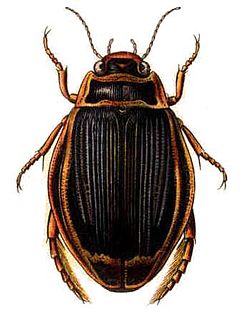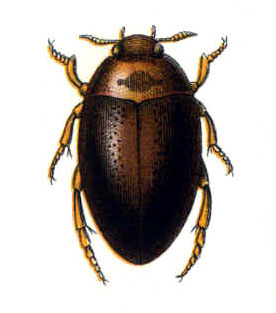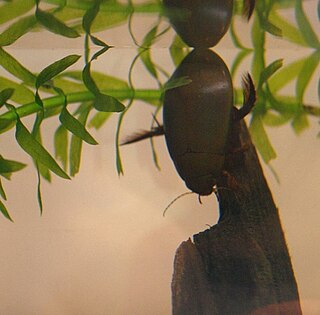
Beetles are a group of insects that form the order Coleoptera, in the superorder Endopterygota. Their front pair of wings are hardened into wing-cases, elytra, distinguishing them from most other insects. The Coleoptera, with about 400,000 species, is the largest of all orders, constituting almost 40% of described insects and 25% of all known animal life-forms; new species are discovered frequently. The largest of all families, the Curculionidae (weevils) with some 83,000 member species, belongs to this order. Found in almost every habitat except the sea and the polar regions, they interact with their ecosystems in several ways: beetles often feed on plants and fungi, break down animal and plant debris, and eat other invertebrates. Some species are serious agricultural pests, such as the Colorado potato beetle, while others such as Coccinellidae eat aphids, scale insects, thrips, and other plant-sucking insects that damage crops.

The whirligig beetles are a family (Gyrinidae) of water beetles that usually swim on the surface of the water if undisturbed, though they swim underwater when threatened. They get their common name from their habit of swimming rapidly in circles when alarmed, and are also notable for their divided eyes which are believed to enable them to see both above and below water. The family includes some 700 extant species worldwide, in 15 genera, plus a few fossil species. Most species are very similar in general appearance, though they vary in size from perhaps 3 mm to 18 mm in length. They tend to be flattened and rounded in cross section, in plain view as seen from above, and in longitudinal section. In fact their shape is a good first approximation to an ellipsoid, with legs and other appendages fitting closely into a streamlined surface.

A water beetle is a generalized name for any beetle that is adapted to living in water at any point in its life cycle. Most water beetles can only live in fresh water, with a few marine species that live in the intertidal zone or littoral zone. There are approximately 2000 species of true water beetles native to lands throughout the world.

The Haliplidae are a family of water beetles who swim using an alternating motion of the legs. They are therefore clumsy in water, and prefer to get around by crawling. The family consists of about 200 species in 5 genera, distributed wherever there is freshwater habitat; it is the only extant member of superfamily Haliploidea. They are also known as crawling water beetles or haliplids.

Dytiscus is a Holarctic genus of predaceous diving beetles that usually live in wetlands and ponds. There are 26 species in this genus distributed in Europe, Asia, North Africa and North and Central America. They are predators that can reduce mosquito larvae.

Noteridae is a family of water beetles closely related to the Dytiscidae, and formerly classified with them. They are mainly distinguished by the presence of a distinctive "noterid platform" underneath, in the form of a plate between the second and third pair of legs. The family consists of about 230 species in 14 genera, and is found worldwide, more commonly in the tropics. They are sometimes referred to as burrowing water beetles.

Amphizoa is a genus of aquatic beetles in the suborder Adephaga, placed in its own monogeneric family, Amphizoidae. There are five known species of Amphizoa, three in western North America and two in eastern palearctic. They are sometimes referred to by the common name troutstream beetles.
Megadytes ducalis is a species of water beetle in the family Dytiscidae. With a length of 4.75 cm (1.9 in), it is the largest species in the family. The species is only known from a single specimen that was collected in the 1800s from an unknown locality in Brazil, although rumors indicate it was found in the bottom of a canoe in the Amazon. As a consequence of the lack of recent records, the IUCN lists it as extinct. Considering the almost complete absence of information about the species and the limited studies conducted on water beetles in Brazil, it might still survive.
Megadytes is a genus of diving beetles in the family Dytiscidae. They are found in slow-moving or static freshwater habitats throughout most of the Neotropics, ranging from Florida and Mexico, through the West Indies and Central America, to South America as far south as central Argentina. The adult beetles measure 1.65–4.75 cm (0.6–1.9 in) long depending on the exact species and the largest is also the largest in the family.

Thermonectus marmoratus is a relatively colorful North American species of diving beetle known by the common names sunburst diving beetle and spotted diving beetle. The behavior of this diving beetle has been compared to a scuba diver, since it carries with it a bubble of air as it dives down into the water. The beetle has recently become notable when it was discovered that its aquatic larval stage is the first ever recorded use of bifocal technology in the animal world. The beetle uses in its principal eyes two retinas and two distinct focal planes that are substantially separated, in the manner of bifocals to switch their vision from up-close to distance, for easy and efficient capture of their prey.

Graphoderus austriacus is a species of beetle in family Dytiscidae.
Hygrobia is a genus of aquatic beetles native to Europe, North Africa, China and Australia. It is the only genus in the family Hygrobiidae, also known as the Paelobiidae. These are known commonly as squeak beetles or screech-beetles.

Acilius sulcatus is a species of water beetle in family Dytiscidae.It is fairly large, with color variation shown throughout its range. Typically it is yellow and black.

Meladema coriacea is a species of beetles belonging to the family Dytiscidae.
Hyphydrus loriae is a species of beetles of the family Dytiscidae.

Dytiscinae is a subfamily of predaceous diving beetles in the family Dytiscidae. There are at least 20 genera and 380 described species in Dytiscinae.
Megadytes fraternus is a species of predaceous diving beetle in the family Dytiscidae. It is found in North America and the Neotropics.

Cybistrini is a tribe of predaceous diving beetles in the family Dytiscidae. There are about 7 genera and more than 140 described species in Cybistrini.

Cybistrinae is a subfamily of predaceous diving beetles in the family Dytiscidae. There are about 7 genera and more than 140 described species in Cybistrinae.


















